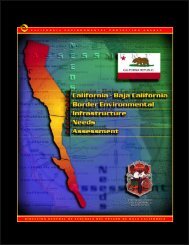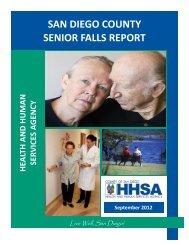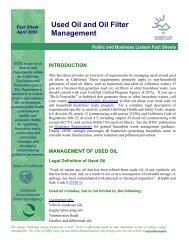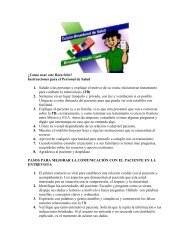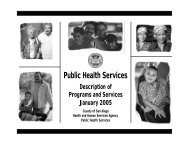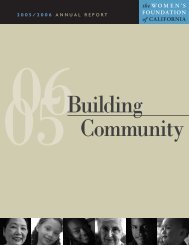United States-Mexico Border Health Commission Annual Report 2003
United States-Mexico Border Health Commission Annual Report 2003
United States-Mexico Border Health Commission Annual Report 2003
You also want an ePaper? Increase the reach of your titles
YUMPU automatically turns print PDFs into web optimized ePapers that Google loves.
<strong>United</strong> <strong>States</strong> Specific:<br />
• Establish or expand border community and migrant health access points; and<br />
• Develop mechanisms that can alleviate and reimburse states for uncompensated<br />
medical costs for uninsured and underinsured care.<br />
<strong>Mexico</strong> Specific:<br />
• Support the <strong>Commission</strong> in the implementation of the Protección Financiera para<br />
la Salud program (Seguro Popular /Popular <strong>Health</strong> Insurance) and the Vete Sano,<br />
Regresa Sano program (Go <strong>Health</strong>y, Return <strong>Health</strong>y) in the <strong>Mexico</strong> border states.<br />
Improved Disease Prevention Efforts, <strong>Health</strong> Education Delivery and Disease<br />
Control Procedures<br />
Chronic diseases are the leading causes of death and disability in the U.S.-<strong>Mexico</strong> border<br />
region. Although chronic diseases are among the most common and costly health<br />
problems, they are also among the most preventable. Adopting healthy lifestyles, such as<br />
eating nutritious foods, being physically active and avoiding tobacco use, can prevent or<br />
control the devastating effects of these diseases.<br />
The <strong>Commission</strong>’s <strong>Health</strong>y <strong>Border</strong> 2010 agenda has health objectives specific to the<br />
border region that call for the elimination of health disparities within the decade. The<br />
objectives focus on the conditions and diseases that have the most glaring and persistent<br />
gaps among vulnerable populations, including prenatal care, tuberculosis, cancer,<br />
diabetes, HIV/AIDS and immunizations, and promote healthy outcomes.<br />
The <strong>Commission</strong> recognizes that much can be done to prevent these conditions and that<br />
resources focused on these areas are a wise investment. Initiatives that promote health<br />
education and healthy lifestyles, such as Steps to a <strong>Health</strong>ier U.S., should be adapted to<br />
the needs of the border region and expanded to work sites, schools, faith communities<br />
and health care settings.<br />
The <strong>Commission</strong> asks the governments to:<br />
• Use the <strong>Commission</strong>’s <strong>Health</strong>y <strong>Border</strong> 2010 agenda as a tool for health planning,<br />
research and assessment of health disparities;<br />
12



